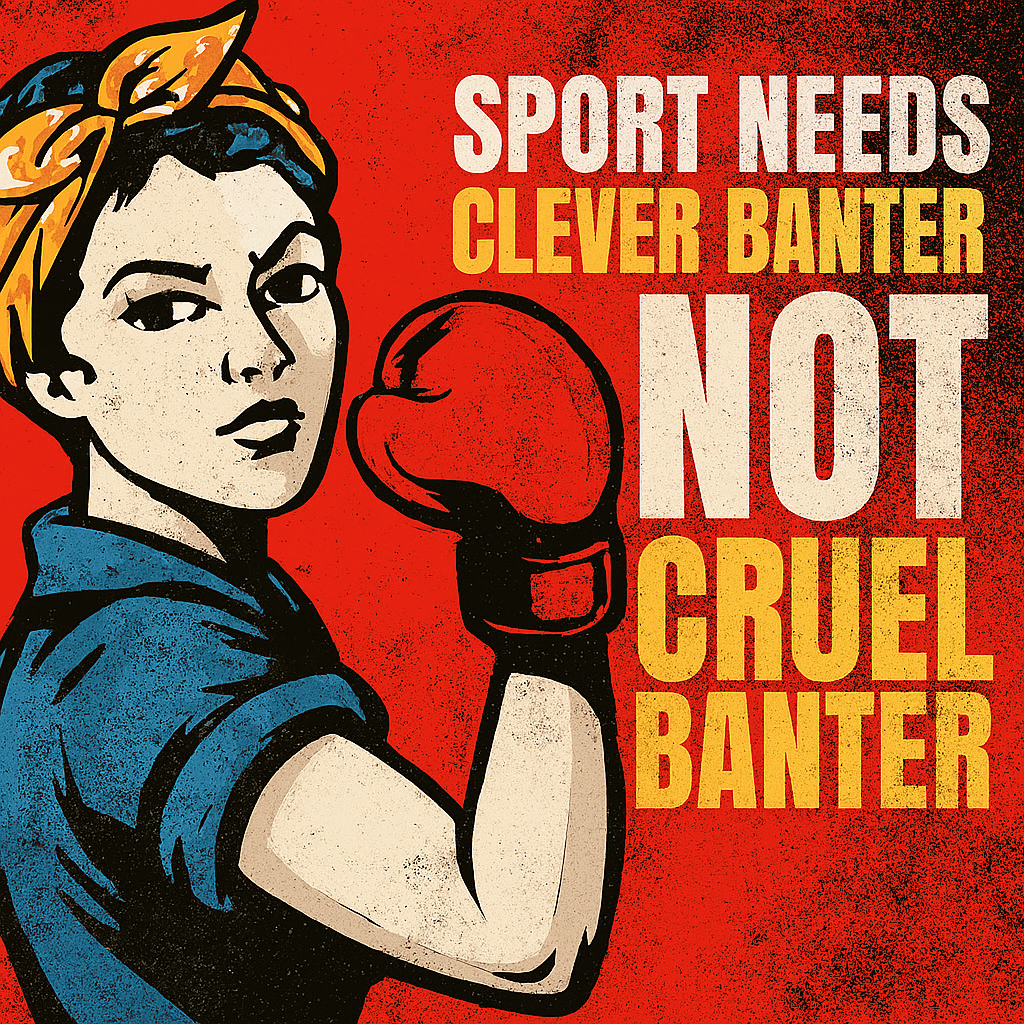Restoring Team Identity – Reconnecting with Fans and Culture after Cheating
Cheating Institutional Recovery – Emotional Repair and Structural Reform
Cheating in sports is more than a breach of rules. It is a violation of the emotional and ethical contract that binds athletes, fans, institutions, and communities. When a team or individual is caught in dishonest behavior, the fallout extends far beyond the scoreboard. The damage touches reputations, relationships, and the very meaning of competition. Fans who once cheered with pride may feel betrayed, disillusioned, or even complicit. Athletes who trained with discipline and sacrifice may see their efforts overshadowed by scandal. Coaches and staff may lose authority, and sponsors may distance themselves to protect their own credibility. The ripple effects can destabilize youth programs, community outreach, and long-term development pipelines. In some cases, entire leagues or governing bodies face scrutiny for enabling or ignoring misconduct. The emotional toll is equally severe, with guilt, shame, and public backlash affecting everyone involved. Recovery from such a rupture demands more than punishment. It requires a comprehensive, multi-layered strategy that addresses emotional healing, cultural transformation, and institutional reform. Redemption is not automatic—it must be earned through sustained effort and transparency. The goal is not to erase the past but to transform it into a foundation for growth. Sports are a reflection of society, and how we respond to cheating reveals our values. By examining the anatomy of recovery, we can better understand what it takes to rebuild with integrity. The journey is difficult, but it is also necessary. In the end, redemption in sport is not just about winning again—it is about earning the right to be believed in.

Assessing the Full Scope of Damage – Beyond the Headlines
Before any meaningful recovery can begin, teams must assess the full scope of damage caused by cheating. This process involves more than reviewing penalties or public reactions. It requires a deep and honest evaluation of how the misconduct affected individuals, relationships, and systems. Athletes may face suspensions, loss of endorsements, and long-term reputational harm. Their mental health may suffer due to guilt, shame, or isolation. Coaches and staff may experience diminished authority and internal distrust, especially if they were complicit or unaware. Fans often feel betrayed, leading to disengagement, vocal criticism, or even organized boycotts. Sponsors may withdraw funding or demand public distancing to protect their brand image. Youth programs can suffer collateral damage, as parents and educators question the values being taught. The broader community may lose faith in the sport’s integrity, affecting attendance, media coverage, and grassroots participation. Governing bodies may face scrutiny for oversight failures or inconsistent enforcement. The damage also includes internal team dynamics, where trust among teammates may be fractured. Staff morale can plummet, and the sense of shared purpose may dissolve. The psychological toll is significant, with emotional exhaustion and identity crises affecting those involved. A comprehensive damage assessment must include interviews, surveys, and open forums to gather honest feedback. It should also involve external experts to ensure objectivity and depth. Understanding the full scope of harm is not about assigning blame—it is about preparing for authentic recovery. Only by acknowledging every layer of impact can teams begin to rebuild with clarity and purpose. This process sets the stage for accountability, reform, and emotional repair. It also signals to stakeholders that the team is serious about change. In the absence of such assessment, any recovery effort risks being superficial or performative. The truth must be faced before trust can be restored.

Establishing Immediate Accountability – Transparency and Consequence
Accountability is the cornerstone of any credible recovery process. When cheating is exposed, teams must respond swiftly and transparently to demonstrate integrity. This begins with public acknowledgment of wrongdoing, without deflection or minimization. Athletes and staff involved must face appropriate consequences, including suspensions, fines, or dismissals. Internal investigations should be conducted independently to ensure fairness and credibility. Cooperation with governing bodies is essential, as is adherence to disciplinary protocols. Leadership must accept responsibility for oversight failures and communicate openly with stakeholders. Public statements should be clear, remorseful, and forward-looking, avoiding legal jargon or public relations spin. Transparency in disciplinary processes helps restore public trust and signals a commitment to reform. Accountability also involves addressing systemic issues, not just individual actions. If the culture enabled or ignored misconduct, structural changes must follow. Teams should publish detailed reports outlining the findings and next steps. This level of openness builds credibility and invites constructive dialogue. Accountability is not solely punitive—it is foundational to healing and transformation. It creates space for emotional repair, cultural reset, and institutional reform. Fans and sponsors respond to sincerity, not spin, and expect meaningful consequences. Athletes who take responsibility and engage in reform efforts can become powerful symbols of redemption. Teams must also support those who were harmed or misled, offering counseling and public acknowledgment. Accountability is a process, not a moment, and must be sustained over time. It requires courage, humility, and a willingness to confront uncomfortable truths. Without it, recovery efforts will lack depth and legitimacy. In the end, accountability is not just about justice—it is about restoring the moral compass of the sport.

Referees and Umpires Cheating – Breach of Neutrality and the Collapse of Fair Play
When referees or umpires engage in cheating, the betrayal cuts deeper than most infractions in sport. These officials are entrusted with the role of impartial guardians—tasked with enforcing rules, maintaining fairness, and protecting the integrity of competition. Their neutrality is foundational to the legitimacy of outcomes. When that trust is violated, the entire framework of sport begins to unravel. Cheating by officials can take many forms, including biased calls, deliberate rule misinterpretation, or covert collusion with teams, athletes, or external interests. In some cases, financial incentives, gambling ties, or personal vendettas have influenced decisions on the field. The consequences are immediate and far-reaching. Athletes lose faith in the fairness of competition. Fans become cynical, questioning whether victories are earned or orchestrated. Teams may feel powerless, knowing that no amount of preparation can overcome a rigged officiating system. The psychological toll is significant—especially in high-stakes matches where a single call can determine careers, championships, or national pride.
Addressing cheating by referees and umpires requires a multi-pronged approach. First, governing bodies must implement rigorous vetting and training processes to ensure ethical standards are deeply embedded. Officials should undergo regular integrity assessments, including psychological evaluations and conflict-of-interest screenings. Technology can play a vital role in reducing human bias—tools like video replay, digital tracking, and AI-assisted decision systems offer transparency and accountability. However, technology alone cannot solve the problem. Cultural reform within officiating communities is essential. This includes peer accountability, whistleblower protections, and clear consequences for misconduct. When cheating is discovered, responses must be swift, public, and proportionate. Officials found guilty should face lifetime bans, legal consequences, and public disclosure of their actions. Transparency in disciplinary processes helps restore trust and signals a zero-tolerance stance.
Rebuilding credibility also involves educating fans and athletes about the systems in place to prevent and detect cheating. Public confidence grows when stakeholders understand how integrity is safeguarded. In some cases, symbolic gestures—such as re-officiating controversial matches or issuing formal apologies—may be necessary to repair emotional damage. Long-term reform should include rotating officiating assignments to prevent familiarity bias, and establishing independent oversight bodies to monitor conduct. Referees and umpires must be reminded that their role is not just technical—it is moral. They are stewards of fairness, and their decisions shape the emotional and historical narrative of sport. When they cheat, they do not just break rules—they fracture belief. Restoring that belief requires structural vigilance, cultural renewal, and emotional repair. In the end, the integrity of sport depends not only on how athletes compete, but on how officials uphold the principles that make competition meaningful.

Leadership Overhaul – Resetting the Moral Compass after Cheating
When cheating or after cheating occurs within a sports organization, it often reveals deeper failures in leadership. The individuals at the helm—whether coaches, executives, or board members—are responsible not only for strategy and performance but also for setting the ethical tone. In many cases, rebuilding trust requires a complete overhaul of leadership. This is not about scapegoating but about acknowledging that the existing structure failed to prevent or detect misconduct. New leadership must be selected with care, prioritizing integrity, emotional intelligence, and a commitment to transparency. Their appointment should be framed as a genuine reset, not a cosmetic change designed to placate critics. These leaders must engage directly with athletes, staff, fans, and sponsors to understand the emotional and operational damage. Listening sessions, open forums, and one-on-one conversations help establish credibility and foster trust. The new leadership must also articulate a clear and actionable vision for reform. This includes revisiting organizational values, updating codes of conduct, and implementing oversight mechanisms. They must be willing to confront uncomfortable truths and dismantle toxic norms. Leadership change should be accompanied by structural audits to identify vulnerabilities and blind spots. The process must be transparent, with regular updates shared publicly. Effective leaders will not only manage the crisis but also inspire a renewed sense of purpose. They must model ethical behavior in every decision and interaction. Their presence should signal a cultural shift that prioritizes accountability and emotional safety. Leadership is not just about authority—it is about stewardship. In the aftermath of cheating, the right leaders can catalyze transformation and guide the team toward redemption.

Understanding After Cheating
Reconstructing Team Culture – From Performance to Principles
Team culture is the invisible architecture that shapes behavior, decisions, and relationships. When cheating occurs, it often reflects a culture that prioritizes results over values. Rebuilding requires a fundamental redefinition of what success means. Teams must move beyond a win-at-all-costs mentality and embrace a more holistic vision that includes integrity, growth, and community impact. This begins with revisiting the team’s mission statement and core values. These should be rewritten collaboratively, involving athletes, coaches, staff, and even fans. Codes of conduct must be updated to reflect ethical expectations and consequences. Training protocols should integrate discussions about fairness, sportsmanship, and personal responsibility. Coaches play a critical role in modeling ethical behavior and reinforcing positive norms. Peer accountability systems can help athletes hold each other to high standards. Team-building exercises should emphasize trust, empathy, and psychological safety. These activities must be ongoing, not one-off events. Culture change should be embedded in daily routines, from practice sessions to travel logistics. Leadership must reward ethical behavior, not just performance metrics. Recognition programs can highlight athletes who demonstrate integrity and teamwork. Feedback loops should be established to monitor cultural health and identify areas for improvement. External facilitators or psychologists may be brought in to support the transition. Culture change takes time and requires consistency, patience, and courage. It must be reinforced through every layer of the organization. In the end, a healthy team culture is the strongest safeguard against future misconduct. It creates a foundation for sustainable success and meaningful connection.
Supporting Mental Health – Healing the Emotional Wounds
Cheating scandals are emotionally traumatic for everyone involved. Athletes may experience guilt, shame, and anxiety, especially if they were complicit or unaware. Coaches and staff may feel betrayed, disillusioned, or powerless. Fans often struggle with anger, disappointment, and a sense of loss. The emotional toll can lead to burnout, depression, and identity crises. Supporting mental health is not a luxury—it is a necessity during recovery. Teams must provide access to professional counseling, therapy, and peer support groups. Mental health professionals can help individuals process complex emotions and rebuild self-worth. Emotional healing also involves rituals of closure, such as team retreats, forgiveness ceremonies, or symbolic gestures. These rituals create space for reflection, reconciliation, and renewal. Teams should normalize conversations about mental health and encourage vulnerability. Coaches and leaders must model emotional openness and seek support themselves. Psychological safety should be prioritized in all team interactions. This means creating environments where individuals feel safe to express concerns, admit mistakes, and ask for help. Mental health support should be integrated into training schedules and performance reviews. It must be treated as a core component of athlete development. Teams can also partner with mental health organizations to provide workshops and resources. Emotional repair is not separate from competitive success—it is foundational to it. Athletes who feel supported are more resilient, focused, and connected. Staff who feel heard are more engaged and effective. Fans who see genuine emotional growth are more likely to re-engage and forgive. Healing takes time, but it is possible with intentional effort and compassionate leadership. In the aftermath of cheating, emotional repair is the bridge between accountability and transformation.

Reconnecting with Fans – Rebuilding the Emotional Contract
Fans are not passive observers—they are emotional stakeholders in the identity and legacy of a sports team. When cheating occurs, the bond between fans and the team is fractured. Many feel betrayed, not just by the act itself, but by the erosion of values they believed the team represented. Rebuilding this relationship requires more than apologies—it demands sustained, honest engagement. Teams must acknowledge the disappointment and anger of their supporters without defensiveness or spin. Hosting open forums, town halls, and listening sessions allows fans to voice their concerns and feel heard. These conversations should be facilitated with transparency and empathy, not scripted responses. Fan engagement must be two-way, with teams actively incorporating feedback into their reform strategies. Symbolic gestures, such as redesigning jerseys or dedicating games to community causes, can help signal a new chapter. However, symbolism alone is insufficient without substantive change. Teams should involve fans in ethical initiatives, such as youth mentorship programs or integrity campaigns. Rebuilding trust also means being consistent—fans will notice if promises are made but not kept. Communication should be regular, honest, and emotionally intelligent. Social media can be a powerful tool for transparency, but it must be used authentically. Highlighting stories of growth, accountability, and resilience helps reframe the narrative. Fans want to see that lessons have been learned and that values are being restored. Loyalty is not automatic—it must be earned through action. Teams should also recognize that some fans may never return, and that rebuilding is a long-term process. The goal is not to erase the past but to build a future rooted in shared values. When done well, fan reconciliation can become a powerful symbol of redemption and community healing.
Managing Media Relations – Controlling the Narrative with Integrity
Media coverage shapes public perception, and in the wake of a cheating scandal, the narrative can quickly spiral out of control. Teams must approach media relations with strategic clarity and ethical transparency. The goal is not to manipulate the story but to provide context, demonstrate accountability, and share the journey of reform. Initial statements should be direct, remorseful, and free of legal jargon or evasive language. Avoiding defensiveness is crucial—media outlets respond more favorably to sincerity than to spin. Teams should designate credible spokespeople who can speak with emotional intelligence and factual precision. These individuals must be prepared to answer difficult questions and acknowledge past failures. Long-form media formats, such as documentaries or in-depth interviews, can offer space for reflection and storytelling. These platforms allow athletes, coaches, and staff to share their experiences and lessons learned. Including internal voices humanizes the recovery process and fosters empathy. Media engagement should be proactive, not reactive. Waiting for coverage to die down or hoping the story fades is a missed opportunity for transformation. Teams can also collaborate with journalists who specialize in ethics, psychology, or sports culture to provide nuanced analysis. Transparency in media interactions builds credibility and helps shift the narrative from scandal to growth. Press releases should be supplemented with behind-the-scenes content that shows reform in action. Visual storytelling—such as training footage, community outreach, or leadership changes—can reinforce the message. Media strategy must be aligned with internal reform efforts; otherwise, it risks appearing performative. Teams should monitor coverage and respond to misinformation with clarity and respect. The media is not the enemy—it is a mirror. How a team engages with it reflects its values and intentions. Done well, media relations can become a platform for redemption and a catalyst for cultural change.

Engaging Youth and Community – Restoring Grassroots Trust
Cheating scandals often have ripple effects that reach far beyond professional arenas. Youth programs, local clubs, and community initiatives may suffer reputational damage, especially if they are affiliated with the team in question. Restoring grassroots trust requires direct, sustained engagement with the communities most affected. Teams must recognize that young athletes look to professionals as role models, and that misconduct can undermine their belief in fairness and hard work. Rebuilding begins with outreach—visiting schools, hosting clinics, and participating in community events. These interactions should be led by athletes and staff who are committed to transparency and ethical growth. Sharing personal stories of accountability and resilience can inspire young people and rebuild emotional connection. Community engagement must be consistent, not symbolic. One-off events are not enough to restore trust. Teams should invest in long-term partnerships with local organizations, offering resources, mentorship, and educational programming. Ethics education should be integrated into youth training, emphasizing values alongside skills. Coaches and volunteers must be trained to foster inclusive, respectful environments. Teams can also create youth advisory boards to give young athletes a voice in reform efforts. Listening to their perspectives helps ensure that recovery is grounded in real needs. Community service projects—such as environmental cleanups, food drives, or mental health campaigns—can demonstrate a renewed commitment to social responsibility. These efforts should be documented and shared to reinforce transparency. Rebuilding grassroots trust is not just about reputation—it is about legacy. Teams must show that they are willing to earn back respect through action, not just words. When communities feel seen, heard, and supported, they become powerful allies in the journey of redemption. Youth engagement is not peripheral—it is central to restoring the soul of sport. Cheating Is an ideology that can have a long-term change on a humans mental health.
Reforming Institutional Policies – Closing the Gaps
Cheating in sports often reveals systemic vulnerabilities that extend beyond individual misconduct. These gaps may include unclear codes of conduct, weak enforcement mechanisms, or inadequate oversight structures. Reforming institutional policies is essential to prevent recurrence and restore credibility. The process begins with a comprehensive review of existing governance frameworks. Teams must identify where policies failed, whether through ambiguity, lack of enforcement, or cultural blind spots. This review should be conducted by independent experts to ensure objectivity and rigor. Updated policies must be clearly written, accessible to all stakeholders, and aligned with ethical best practices. Codes of conduct should be revised to include specific expectations around honesty, fairness, and accountability. Whistleblower protections must be strengthened to encourage reporting without fear of retaliation. Ethics training should be mandatory for athletes, coaches, and staff, with regular refreshers built into the calendar. Oversight bodies should be restructured to include diverse perspectives and external accountability. Transparency in policy development is crucial—teams should publish reform roadmaps and progress updates. These documents signal commitment and invite public scrutiny. Institutional reform must also address incentive structures that may have contributed to unethical behavior. If performance bonuses or contract renewals are tied solely to wins, they may unintentionally encourage rule-breaking. Teams should explore more holistic evaluation criteria that include leadership, sportsmanship, and community engagement. Technology can support reform through digital compliance tracking and anonymous reporting platforms. Legal teams should collaborate with ethics advisors to ensure that reforms are enforceable and aligned with broader regulations. Institutional change is slow but necessary. It creates the scaffolding for cultural transformation and long-term integrity. Without it, emotional repair and symbolic gestures risk being undermined by structural inertia. Reforming policies is not about bureaucracy—it is about building a resilient foundation for ethical sport.

Creating Symbolic Change – Rituals That Resonate
Symbolic gestures play a vital role in emotional recovery and cultural transformation. While policy reform addresses structure, symbolism speaks to identity and meaning. In the aftermath of cheating, teams must find ways to mark the transition from scandal to renewal. These gestures should be authentic, emotionally resonant, and aligned with broader reform efforts. Retiring a jersey number associated with the scandal may signal closure and respect. Redesigning the team logo or uniform can represent a fresh start and a new chapter. Ceremonies of reflection, such as moments of silence or public acknowledgments, help create shared space for healing. Teams may choose to plant trees, dedicate murals, or establish scholarships in honor of integrity and resilience. These actions are not superficial—they anchor emotional transformation in tangible form. Symbolic change must be inclusive, involving athletes, staff, fans, and community members. Rituals should be co-created, not imposed, to ensure relevance and authenticity. Storytelling is a powerful tool in this process. Sharing narratives of growth, accountability, and redemption helps reframe the team’s identity. Visual storytelling, such as documentaries or photo essays, can reinforce these messages. Symbolism should also be embedded in daily routines. Locker room signage, training mantras, and team chants can reflect renewed values. Coaches and leaders must model these symbols in their behavior and language. Symbolic change is most effective when paired with structural reform and emotional support. It creates coherence between what a team says and what it does. Fans respond deeply to symbolism, especially when it reflects sincerity and courage. These gestures become part of the team’s legacy, shaping how future generations understand its journey. In the end, symbolic change is not about forgetting the past—it is about transforming it into a source of strength and wisdom.
Rethinking Performance Metrics – Ethics as a Core Value
Traditional performance metrics in sports often prioritize outcomes such as wins, rankings, and statistics. While these indicators are important, they can inadvertently incentivize unethical behavior if not balanced with values-based criteria. In the wake of cheating, teams must rethink how success is defined and measured. This begins with integrating ethics into performance evaluations. Athletes should be assessed not only on physical output but also on leadership, teamwork, and adherence to ethical standards. Coaches must reward behaviors that reflect integrity, such as honesty in competition and respect for opponents. Training programs should include modules on ethical decision-making, with real-world scenarios and role-playing exercises. Performance reviews should be holistic, combining quantitative data with qualitative feedback. Peer evaluations can provide insight into interpersonal dynamics and cultural contributions. Teams may choose to develop integrity scorecards that track ethical behavior over time. These tools should be transparent and used constructively, not punitively. Incentive structures must be revisited to ensure they align with ethical goals. Bonuses, promotions, and public recognition should reflect values as well as results. Leadership must communicate clearly that integrity is non-negotiable and central to the team’s identity. This message should be reinforced through rituals, storytelling, and daily interactions. Rethinking metrics also involves engaging fans and sponsors in the conversation. Public expectations are evolving, and many stakeholders value ethical conduct as much as competitive success. Teams can publish annual integrity reports that highlight progress and challenges. These documents build trust and demonstrate accountability. Ethical metrics should be dynamic, adapting to cultural shifts and emerging best practices. They must be embedded in the team’s DNA, not treated as add-ons. When ethics are treated as core performance indicators, they become part of the competitive advantage. Athletes who feel supported in their values are more resilient, focused, and connected. In the long run, ethical excellence is not a compromise—it is a catalyst for sustainable success.
Rebuilding Brand Identity – Restoring Public Confidence
A team’s brand is more than its logo or merchandise—it is the emotional and symbolic representation of its values, legacy, and relationship with the public. When cheating occurs, that brand is compromised. Fans, sponsors, and media no longer associate the team with excellence or integrity but with scandal and betrayal. Rebuilding brand identity requires a deliberate and transparent effort to redefine what the team stands for. This begins with acknowledging the damage and committing to a new direction. Visual elements such as logos, uniforms, and promotional materials may be redesigned to reflect a fresh start. However, these changes must be backed by substantive reform. Marketing campaigns should highlight ethical commitments, community engagement, and emotional growth. Storytelling plays a crucial role—sharing narratives of accountability, resilience, and transformation helps reframe public perception. Athletes and staff should be involved in these efforts, offering authentic voices that resonate with fans. Sponsorships must be re-evaluated, with partners chosen based on shared values rather than financial convenience. Transparency in brand messaging is essential—audiences are quick to detect insincerity. Teams should publish annual reports detailing reform progress, community impact, and ethical benchmarks. These documents build trust and demonstrate accountability. Social media engagement should be honest and interactive, allowing fans to participate in the brand’s evolution. Community outreach programs can reinforce the team’s renewed identity, especially when they involve youth, education, and social responsibility. Rebuilding brand identity is not about erasing the past but about transforming it into a foundation for future integrity. It requires consistency, emotional intelligence, and a willingness to listen. When done well, a reimagined brand can become a powerful symbol of redemption and resilience. It can inspire loyalty, attract new supporters, and restore the emotional connection that defines sport at its best.

Strengthening Legal Oversight – Ensuring Compliance
Legal oversight is often the most overlooked aspect of recovery, yet it is essential for institutional integrity. Cheating exposes not only ethical failures but also legal vulnerabilities. Contracts may lack clear clauses on misconduct, compliance protocols may be outdated, and governance structures may be ill-equipped to enforce accountability. Strengthening legal oversight begins with a comprehensive audit of all legal frameworks within the organization. This includes athlete agreements, staff contracts, sponsorship deals, and internal bylaws. Legal teams must collaborate with ethics experts to ensure that all documents reflect current best practices and regulatory standards. Whistleblower protections should be codified and enforced, allowing individuals to report concerns without fear of retaliation. Compliance protocols must be updated to include regular reviews, training sessions, and enforcement mechanisms. These systems should be proactive, not reactive, identifying risks before they escalate. Legal reform also involves clarifying roles and responsibilities across departments. Everyone from coaches to marketing staff must understand their obligations and the consequences of misconduct. Technology can support compliance through digital tracking, automated alerts, and secure reporting platforms. External legal advisors may be brought in to ensure objectivity and rigor. Transparency in legal reform builds credibility with fans, sponsors, and governing bodies. Teams should publish summaries of legal updates and invite feedback from stakeholders. Legal oversight must be embedded in the culture, not treated as a bureaucratic formality. It should be part of onboarding, performance reviews, and strategic planning. Strengthening legal frameworks protects the organization from future scandals and reinforces its commitment to integrity. It also empowers individuals to act ethically, knowing that the system supports and protects them. In the long run, robust legal oversight is not just about risk management—it is about building a resilient, trustworthy institution.

Monitoring Progress – Sustaining Long-Term Change
Recovery from a cheat, cheating is not a one-time event—it is a long-term process that requires ongoing evaluation and adaptation. Without sustained monitoring, even the most well-intentioned reforms can lose momentum or become symbolic. Teams must establish systems to track progress across emotional, cultural, and structural dimensions. This begins with setting clear benchmarks for success, including ethical behavior, fan engagement, and institutional reform. Regular audits should be conducted to assess compliance, cultural health, and stakeholder satisfaction. These audits must be transparent and involve external experts to ensure credibility. Feedback loops should be built into every layer of the organization, allowing athletes, staff, and fans to share their experiences and concerns. Surveys, interviews, and open forums can provide valuable insights into the effectiveness of reform efforts. Progress reports should be published annually, detailing achievements, challenges, and next steps. These documents demonstrate accountability and invite public dialogue. Monitoring should also include emotional indicators, such as team cohesion, psychological safety, and mental health outcomes. Cultural metrics—such as peer support, ethical leadership, and community involvement—should be tracked alongside performance data. Technology can support monitoring through dashboards, analytics, and real-time feedback tools. Leadership must be committed to using this data constructively, not defensively. Monitoring is not about control—it is about learning and growth. It allows teams to refine strategies, respond to emerging issues, and celebrate milestones. Sustained evaluation ensures that recovery is not performative but transformative. It builds trust with stakeholders and reinforces the team’s commitment to integrity. In the end, long-term change is only possible when progress is measured, shared, and acted upon. Monitoring is the bridge between intention and impact.

Conclusion – Redemption Through Action
Cheating in sports is a rupture—a moment when trust is broken and values are called into question. But it can also be a catalyst for transformation. Recovery is not easy, and it cannot be rushed. It requires emotional honesty, structural reform, and symbolic renewal. Teams must confront their failures with humility and courage, acknowledging the harm caused and committing to meaningful change. Redemption is not about erasing the past—it is about learning from it and building a future rooted in integrity. Every step of the recovery process, from accountability to community engagement, must be intentional and transparent. Fans, athletes, and institutions must work together to rebuild the emotional and ethical foundation of sport. This journey is not linear—it will involve setbacks, difficult conversations, and moments of doubt. But it is also an opportunity to redefine what success means and to create a culture where values matter as much as victories. When done well, recovery becomes a story of resilience, growth, and hope. It shows that sport is not just about competition—it is about connection, character, and collective meaning. Redemption is earned through action, and it is sustained through consistency. In the end, the true legacy of a team is not how it falls, but how it rises.
Join the Discussion – Share Your Perspective On Cheating
What does redemption look like in sport? How should teams, fans, and institutions respond to cheating in a way that fosters healing and transformation? Is cheating ok if it is only bending the rules and if you do not get caught? Has a cheat changed your life? Whish is the worse cheating moment in sports? How does cheating change sports for you?
#SportsIntegrity #TeamCulture #AthleteAccountability #FanTrust #EthicalLeadership #SportsRecovery #MentalHealthInSports #CommunityEngagement #InstitutionalReform #SymbolicChange #PerformanceEthics #BrandRehabilitation #LegalOversight #LongTermChange #RedemptionInSport














How Silent Training Espionage Is Rewriting the Rules
[…] moral compass. The question isn’t whether spying works—it’s whether it belongs. If victory is built on deception, then the game itself becomes a lie. To preserve the meaning of competition, we must reclaim the […]